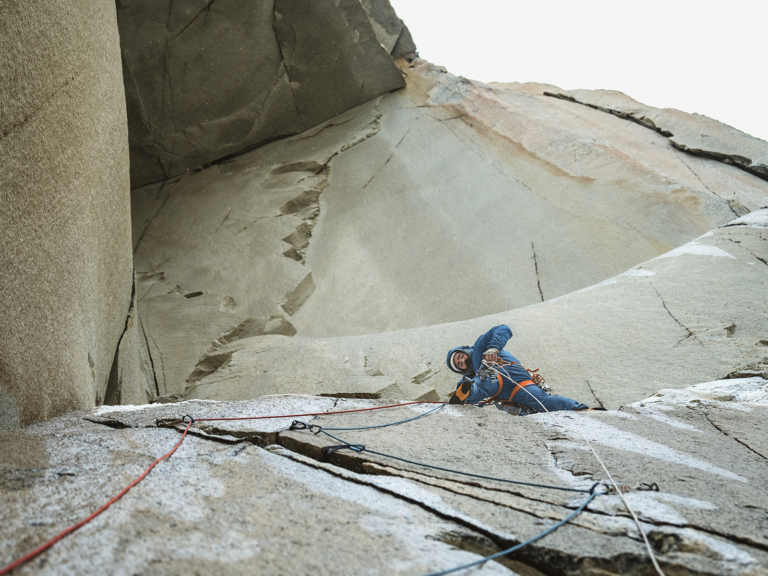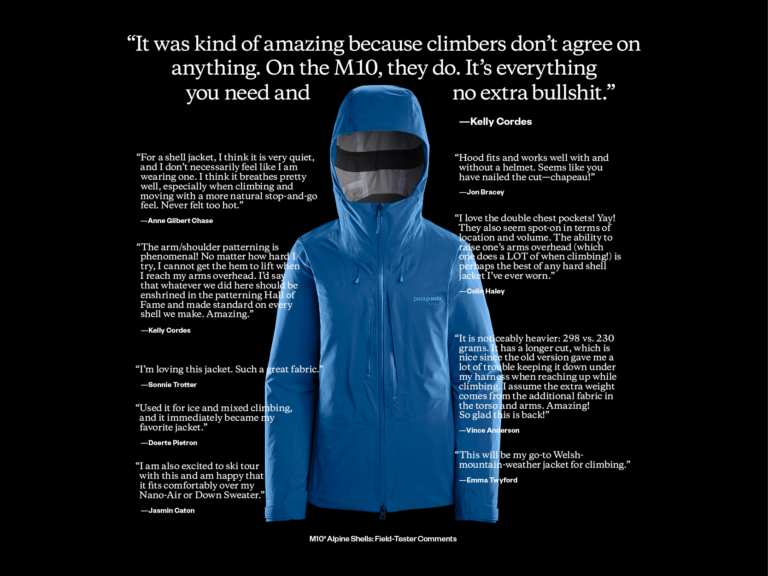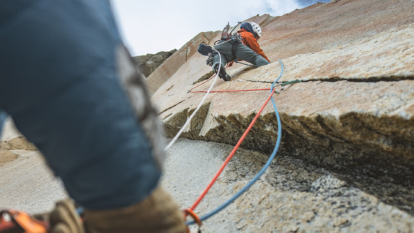M10® Alpine Shells
All photos by Drew Smith
As field-testing coordinator at Patagonia, Kelly Cordes also has to be a herder of cats. When it comes to soliciting and consolidating feedback from the athletes, gearheads and dirtbags who make up the team, it takes hustle. That’s why his report on the new M10® shells was so memorable. Every single climber who had experience with earlier M10 shells responded. And every single one of them said more or less the same thing: Bring M10 back. Don’t mess it up. “It was kind of amazing because climbers don’t agree on anything,” Kelly says.
From its original launch in 2010, the M10 exemplified Patagonia’s design philosophy: There was nothing left to eliminate. Pit zips? Nope. Handwarmer pockets? Nada. Allowing for unrestricted, climb-specific movements, it was the low-bulk, lightweight, waterproof/breathable layer that every alpinist needed.
“It was the first time ‘light and fast’ came to storm protection and really catered to climbers doing big things,” recalls Kate Rutherford, our ambassador turned alpine product line manager. “We never had anything like that before, and it felt like the first time we had really been listened to. That was special.”
After a few years, however, it seemed like we had accomplished what we’d set out to do with the M10. “When all 50 of the most badass ice climbers had one, they didn’t need another one,” Kate says.
In 2018, the M10 dropped out of the line as we explored other sport demands. Yet nothing took its place, and substitutes could be found wanting. The ultralightweight Alpine Houdini® Jacket was, as one field-tester put it, “like wearing a garbage bag.” Another noted that the Super Free Alpine Jacket is more for athletes skinning to and skiing off objectives in addition to climbing them. Alpine climbers simply would never justify the additional weight for things like more pockets, zippers or trims. “It was so clear what everyone wanted from the M10, and that’s why they all liked it in the first place. It’s everything you need and no extra bullshit,” Kelly says. “It’s a Ferrari, a total race car.”

Sean Villanueva O’Driscoll sends pitch 25 of Riders on the Storm, even with most holds filled with snow and ice.
Bringing back the M10, we knew we could push the materials further. The 2024 M10 Storm styles use an even lighter-weight version of the exceptionally weatherproof, breathable 3-layer fabric technology first used in our Dual Aspect shells in 2021, and made without intentionally applied PFCs/PFAS. We also dropped some car battery tech into the M10 Anorak. Most porous membranes for garments are made chemically, requiring a solvent bath and resulting in randomly sized holes. But automakers developed a nanoporous membrane that’s made mechanically, stretching the material to get uniform, nano-sized holes. The Xpore® nanoporous membrane in the M10 Anorak is made like those in car batteries, with consistently sized pores that keep rain and snow out but still let sweat and heat escape, resulting in a highly waterproof/breathable material made without harsh chemicals.
“It’s exciting to bring badass technologies from other industries to the outdoors,” Kate says. “The alpine space is a proving ground for these kinds of innovations. If we can make it work high on the mountain, it can service other sport communities, too.”
Even so, the M10 story is all about mobility. Fully waterproof materials aren’t typically stretchy, which means the garment pattern is especially critical in shells. Elísabet Elfa, a technical outerwear designer, and Senior Pattern Engineer Jaimee Redfern took their time and turned to dance for inspiration.
“I’m a trained classical dancer and mostly think as a dancer first,” Elísabet says. “When dancing, nothing should stop a motion or make it harder to perform. When I’ve climbed, I’ve used movements from dance. I think it should feel and look similar, like you do it effortlessly and in a beautiful sequence of movements.” After months of staring at photos of alpine ambassadors’ armpits, ElÍsabet and Jaimee came up with a completely redesigned underarm gusset that even our pickiest field-testers agree provides better mobility than the original M10, with nearly zero hem lift.
Elísabet and Jaimee’s syncretic approach to design can be seen across the new M10 family: Cycling bibs informed the stretchy, zipper-free baselayer access on the M10 Storm Bibs, while the 4-Point Gusset on the M10 Storm Pants came from jiujitsu pants. “It’s cool how focused the M10 pieces are, but it was the zoomed-out concept of mobility that opened up possibilities,” Kelly says. “It’s what our best designers do—observe the broader world to help refine our focus.”
“One of the more unique things about Patagonia is that a new idea can come from anywhere,” Jaimee agrees. “It doesn’t have to come from a specific group of people. It just has to be a good one.”
Visit patagonia.com to see the entire M10 collection.


